AC Milan scored a late winner to beat Genoa at the Stadio Ferraris on Saturday evening, moving to the top of the Serie A table.
In an eventful conclusion to the game that included two red cards and an Olivier Giroud stint between the posts, the Rosseneri eventually managed to find a breakthrough against the hard-working and highly organised home side.
Below are @Tactics_Tweets observations of the game.
Set-Ups
Stefano Pioli continued to rotate his starting lineup, making five changes to their midweek European outing against Borussia Dortmund.
In possession, Milan used Yacine Adli at their base of midfield three, with Yunus Musah and Tijjani Reijnders more advanced towards the entirely new forward line of Samuel Chukwueze, Luka Jović and Noah Okafor.
Out of possession, the visitors often resembled a 4-4-2 shape higher up the pitch, with Reijnders pushing up alongside Jović to engage the home side’s backline.
For Genoa, Alberto Gilardino made one change to their previous game. The home side were very interchangeable with and without the ball, forming various different shapes depending on the phase of play.
First-half gameplans
After an energetic start to the match, the pattern of the game soon emerged.
Genoa were content to concede initial territory to Milan, instead prioritising protecting their own half using a 4-5-1 mid-block which pressed with their midfield 8s alternating to jump up and engage the nearby opponent on the ball.
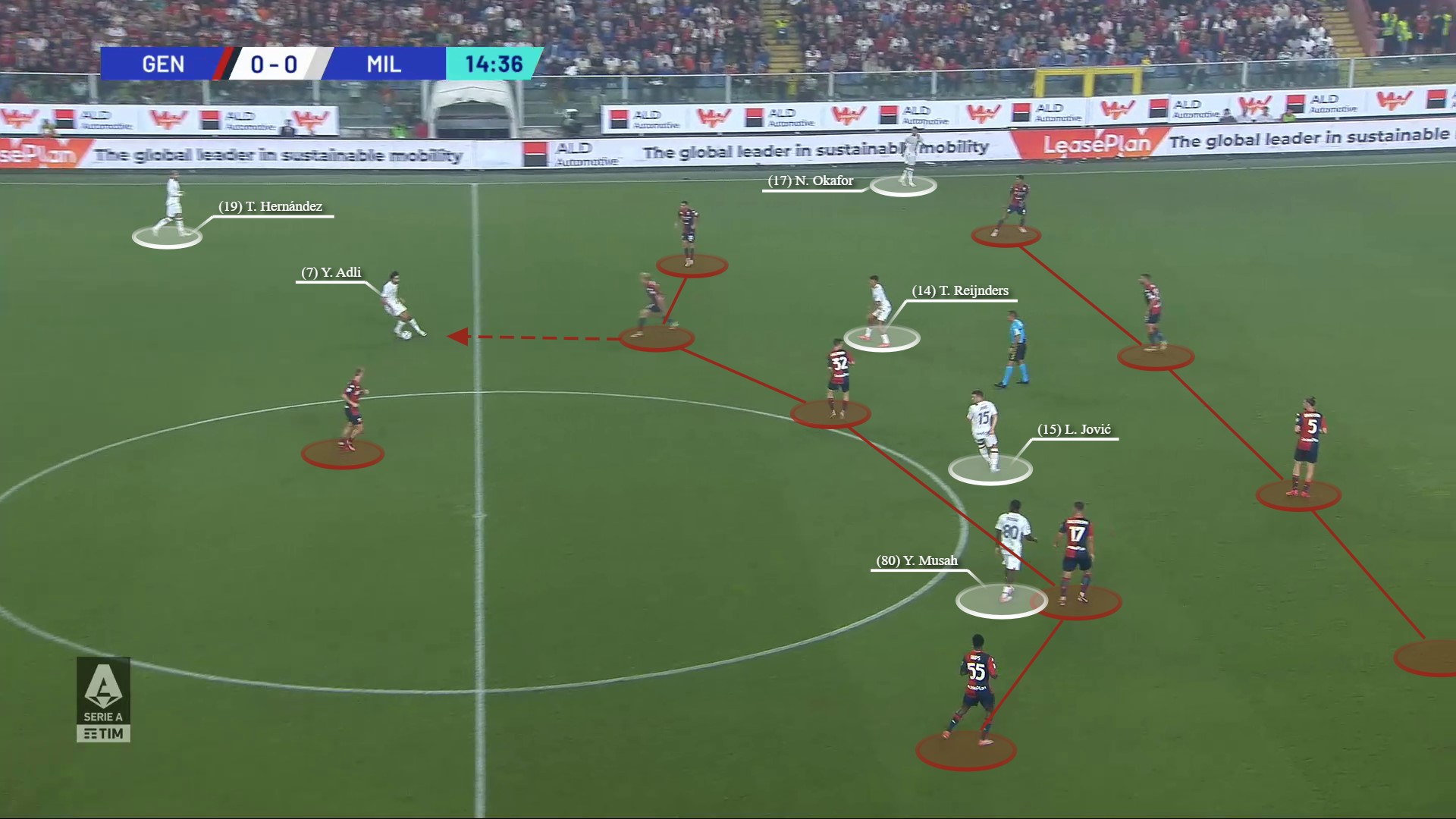
As the home team were forced backwards, closer towards their own goal, this block would collapse into a 5-4-1, or at times even a 6-3-1, to protect their penalty area. With one or both of the wide midfielders dropping into and on the outside of the backline, this allowed the back four to limit the spaces in between them.
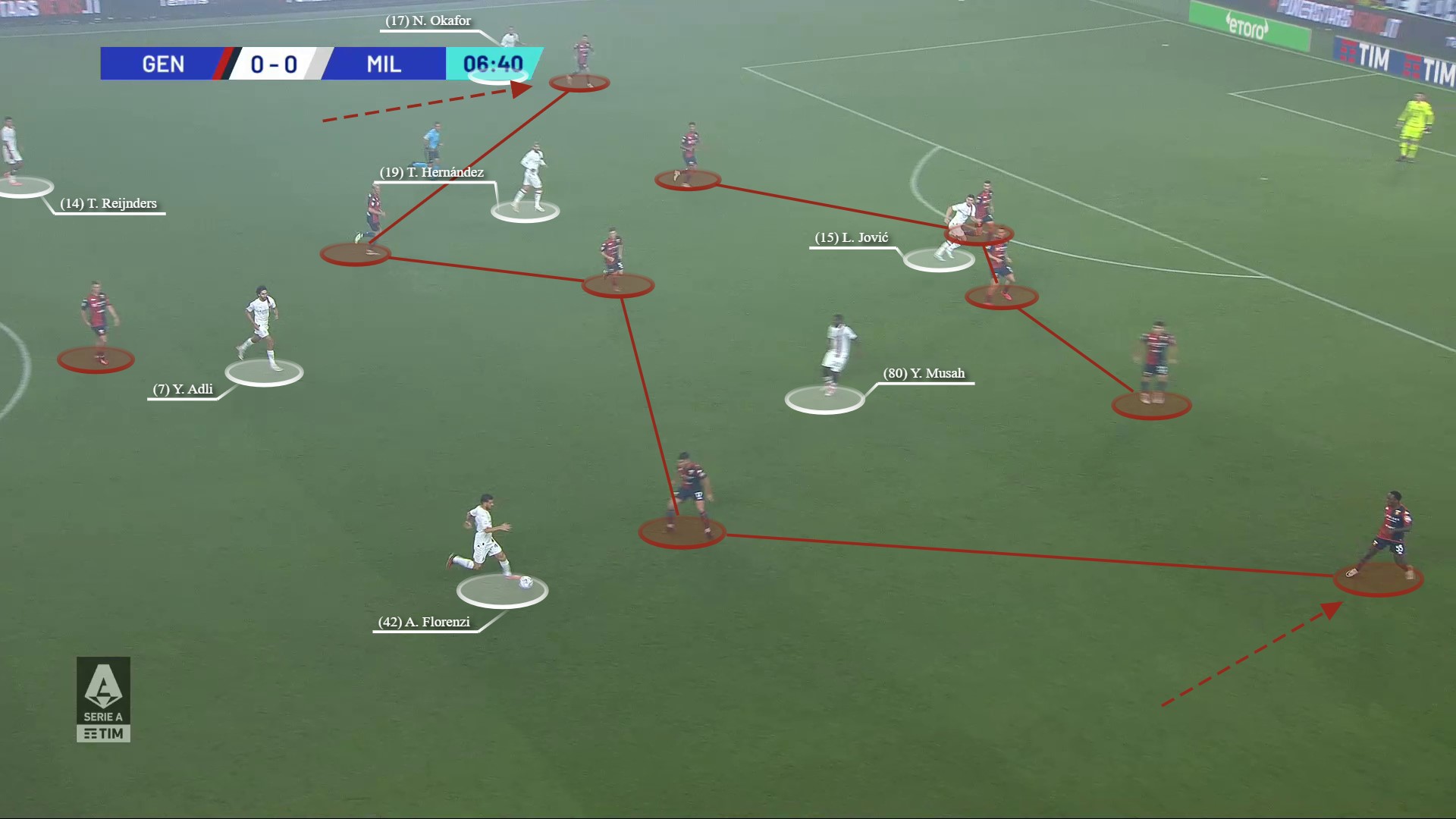
Whatever the ‘numerical’ structure of the Genoa block, maintaining compactness between their defensive lines appeared key with defenders also jumping out of the backline to follow forwards dropping short.
Milan predominantly used their back four and Adli at the base of their in possession shape. Both Alessandro Florenzi and Theo Hernández had license to come infield or stay wider depending on where the spaces were against Genoa’s ever-changing defensive formation. Hernández also interchanged positions with Reijnders to allow the Dutch midfielder to get on the ball more.
The main aims of this five-player base were to circulate possession to draw out and shift the Genoa block and progress the ball forward to their forward line of five – typically positioned with Chukwueze and Okafor holding the width, Musah and Reijnders in the half-spaces trying to find pockets in behind the Genoa midfield jumps, and Jović as a central focal point.
But as mentioned, with little-to-no spaces between the opposition lines for Milan to play in or even access, in the first half, the away side frequently looked to go over the top of the Genoa block to try and exploit the limited spaces available in behind.

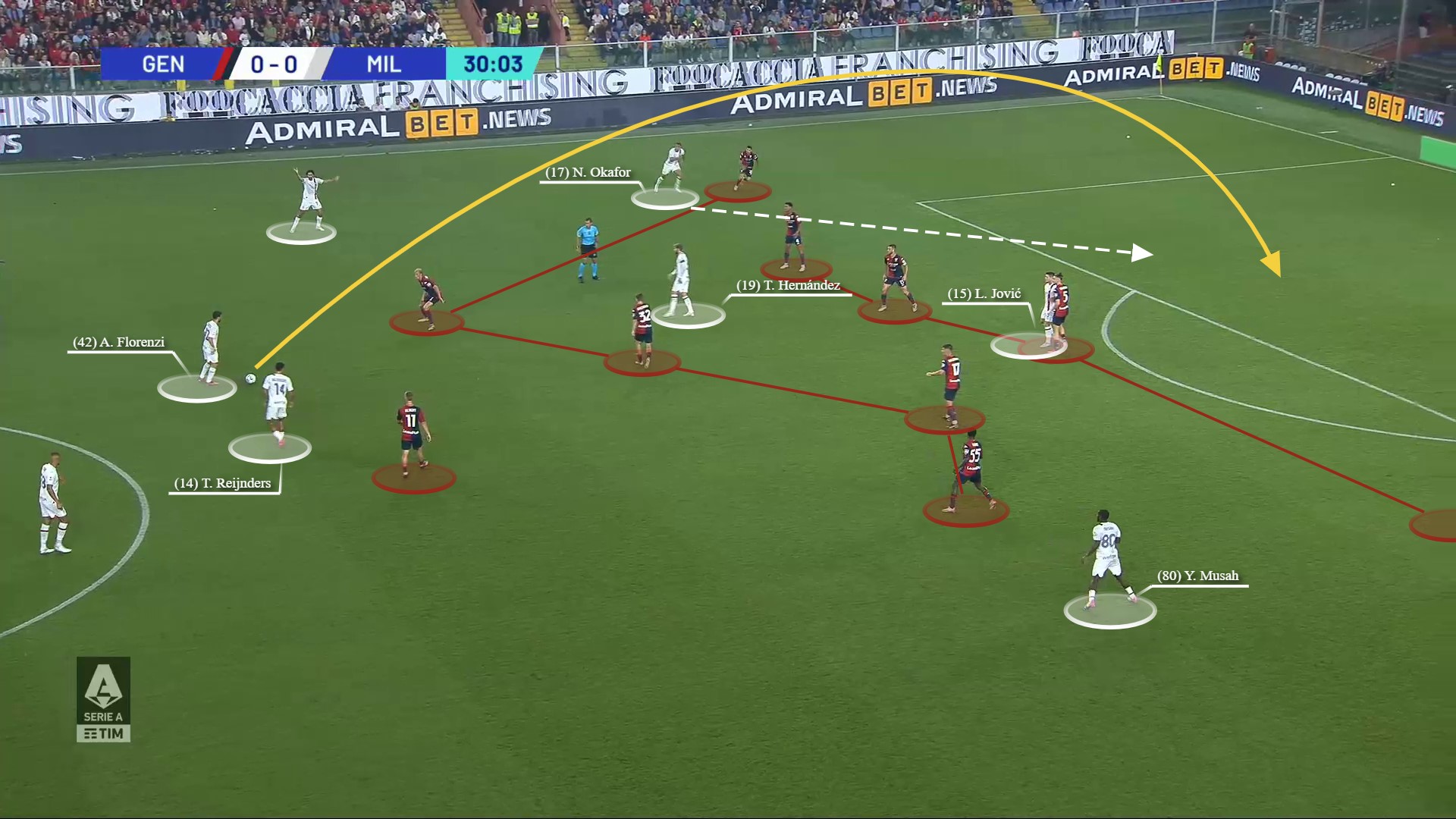
This tactic was also likely an attempt to try and force the hosts backwards or at least offer a different threat to dealing with the constant possession in front of them. Although, in the opening forty-five minutes, this attacking ploy had minimal effectiveness for Milan.
It was not only the out of possession aspects of Genoa’s gameplan that caused Milan issues in the first-half. In addition to counterattacks, Gilardino’s side also used lots of player rotations and positional movements in their build-up play to confuse and disjoint the Rosseneri’s defensive set-up.
The most frequent player rotations involved Morten Frendrup and Ruslan Malinovskyi who constantly swapped the horizontal lines they were positioned on, each becoming the deepest midfielder at times, to evade and catch Milan’s markers off-guard.
As well as player rotations, Genoa also used various positional movements such as, left-back Johan Vásquez pushing higher on the left wing, left winger Ridgeciano Haps coming infield, and Albert Guðmundsson dropping into deeper areas of the pitch, often dragging up a Milan centre-back with him.
Here’s one situation Genoa were able to generate from these types of player rotations and positional movements that eventually led to two shots in quick succession in the 25th minute.
Play started with Josep Martinez who passed into Guðmundsson dropping deep to receive. At this point, Milan are set in their 4-4-2 system.
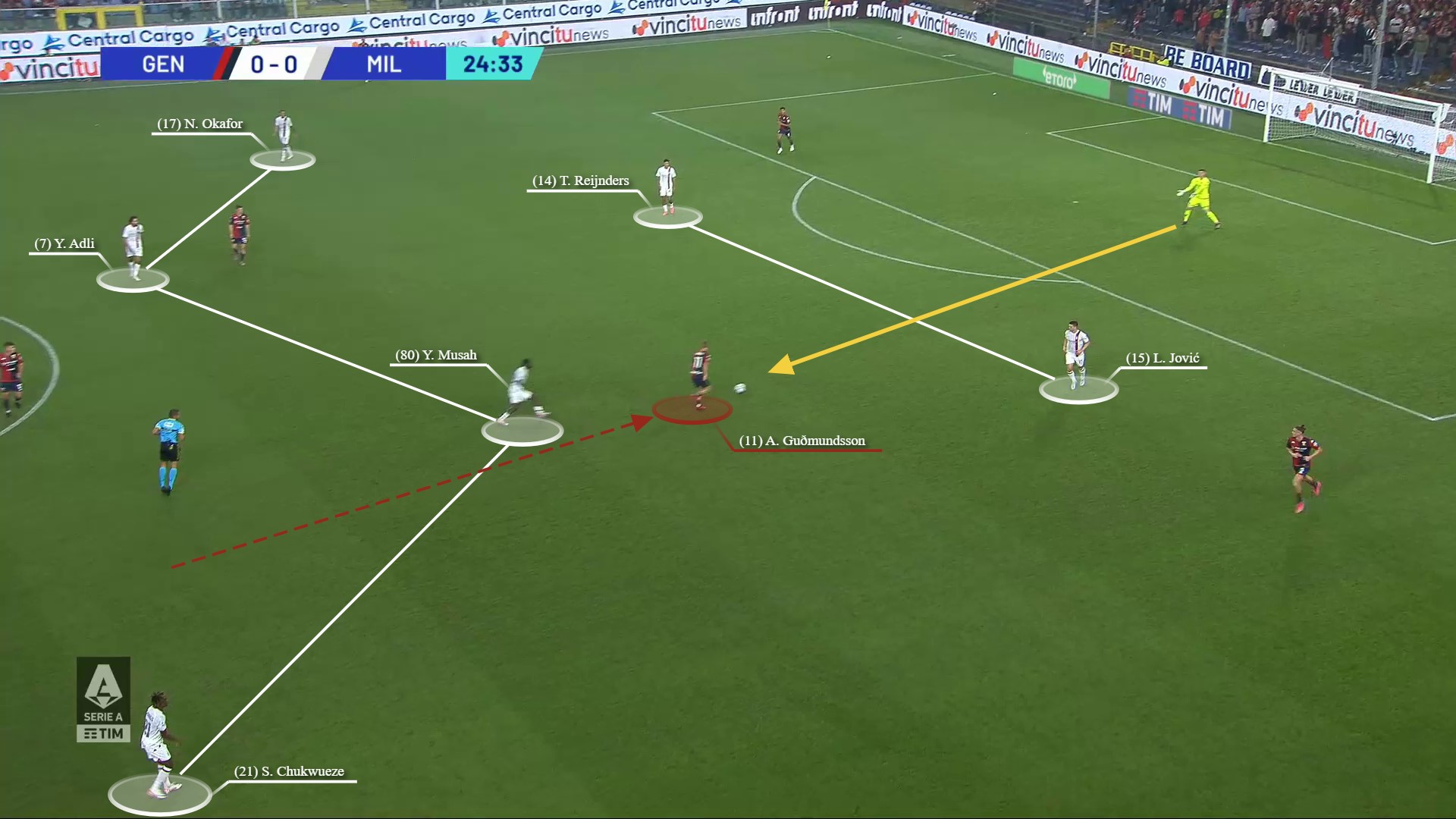
After circulating possession at the back, the ball again found itself at the feet of Martinez. Then, following lots of rotations in central areas between Frendrup, Malinovskyi and Guðmundsson the Milan midfield and Fikayo Tomori (who was initially dragged up the pitch by Guðmundsson) had been suitably disjointed so the Genoa goalkeeper made another pass into Guðmundsson…
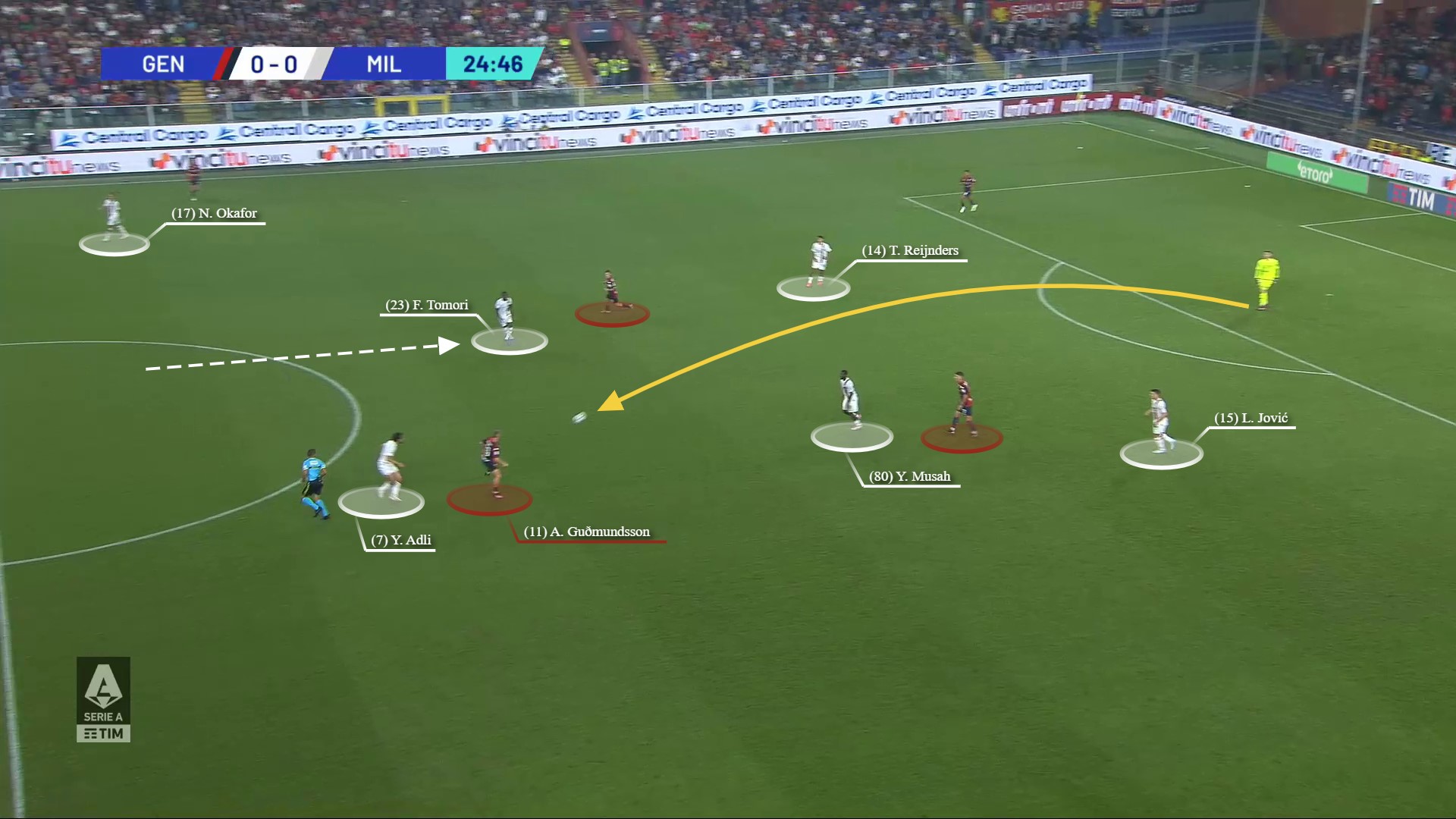
…who after controlling, passed ahead to the advanced Vásquez. Below you can see how disjointed the Milan backline was and the different positions the Genoa players were in.
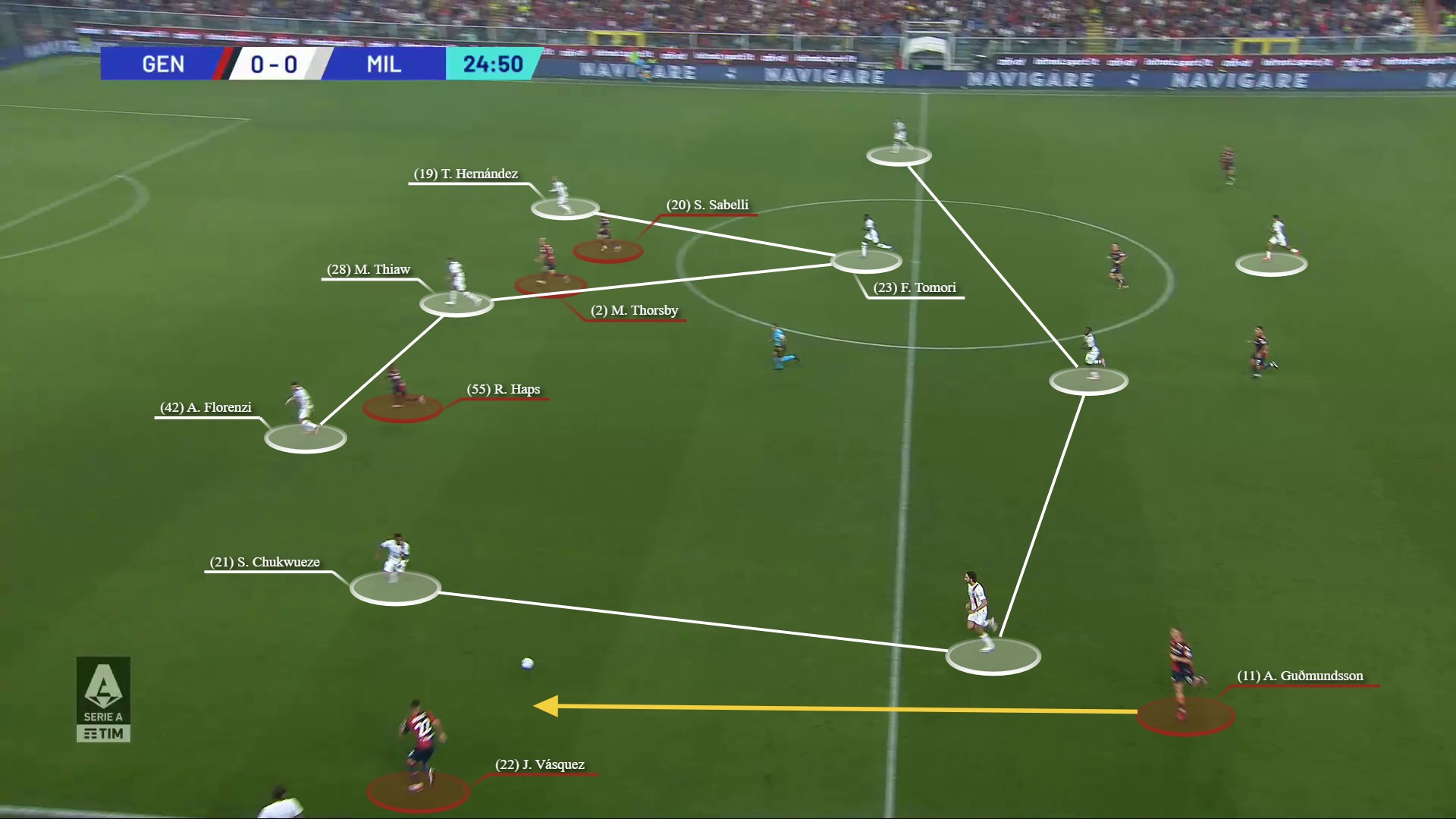
Vásquez took advantage of the unsettled Milan defensive shape to carry the ball towards the penalty area before his shot was blocked and the loose ball fell to Frendrup whose shot sailed over the bar.
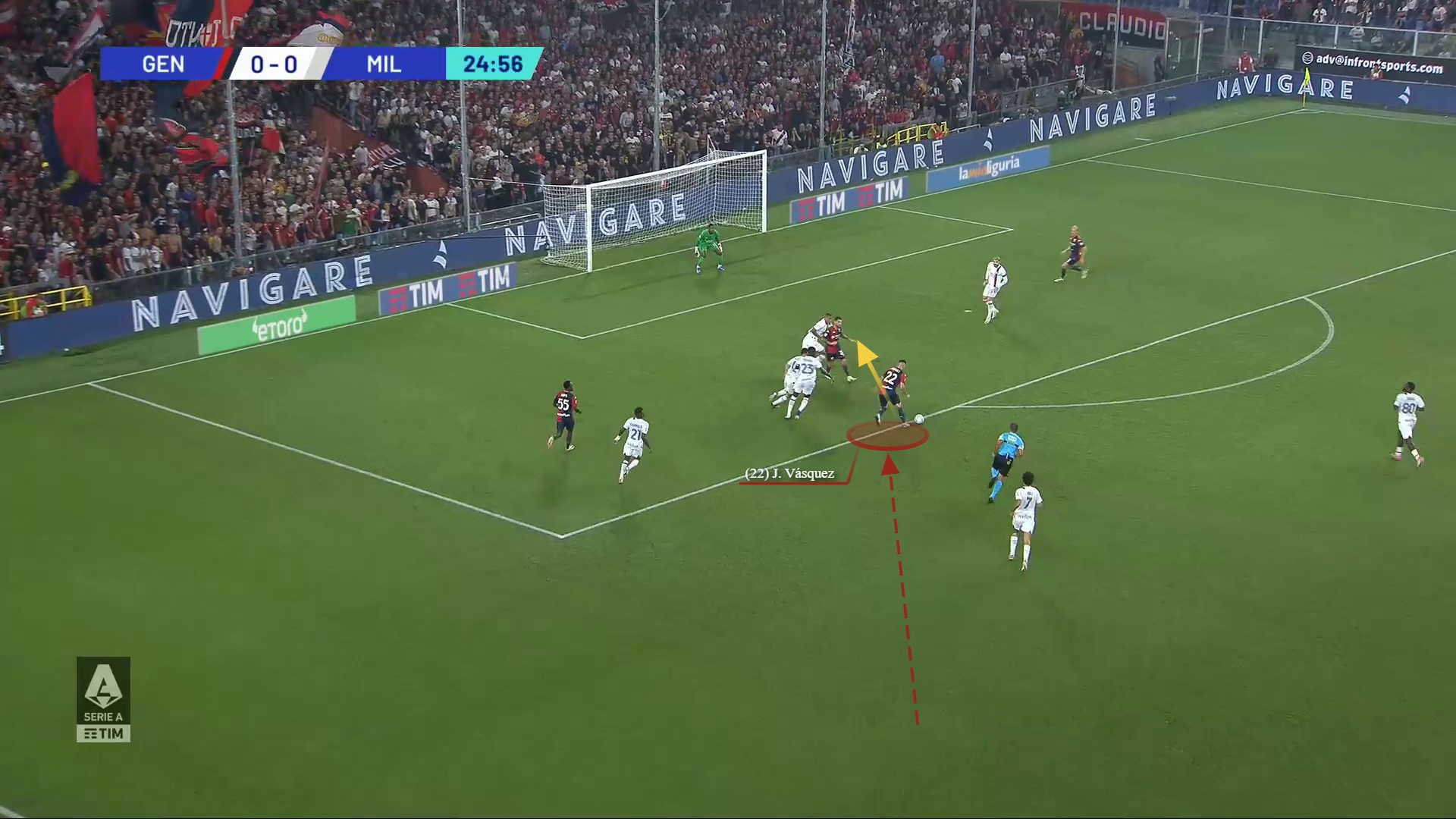
These types of instances, albeit not always leading to shots, occurred frequently in the first-half. So despite Milan having 58% possession (Wyscout) and the majority of territory, Genoa were proving to be a nuisance, both with and without the ball.
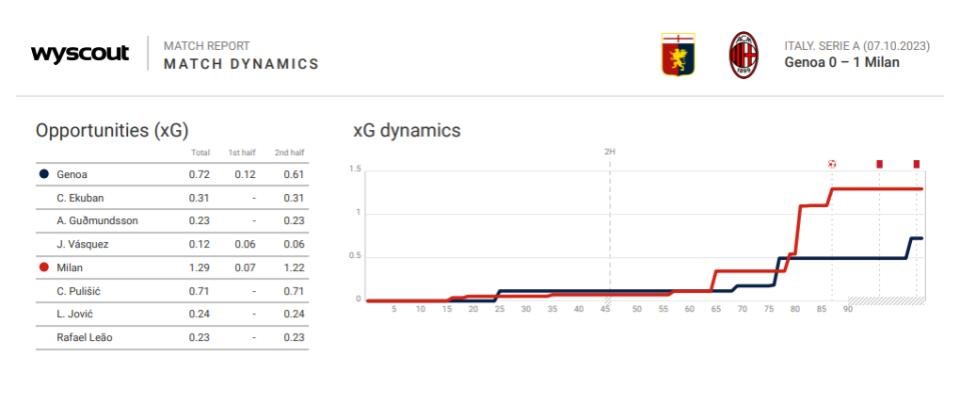
Giroud presence pays off
At half-time, Pioli decided to bring on two of his first-choice attackers, Christian Pulisic and Rafael Leão. These changes did not initially have a major impact on Milan’s fortunes in the final third.
It took until the 65th minute for a major chance to be created when the visitors countered a Genoa counterattack that resulted in a Pulisic cross finding Leão at the far post but his stooping header was palmed over the bar.
With the scoreline still level at twenty-five minutes to go, Piolo opted to make further substitutions which included bringing on Giroud for Adli. With Jović still on the pitch, Milan now had two centre forwards to occupy the Genoa backline and provide additional box presence for crosses.
Around the same time the home team also made substitutions and adjustments to their shape, forming a 5-3-2 block out of possession. However, the combination of both team’s changes only seemed to serve Milan’s benefit.
With the Genoa midfield now unable to provide as much coverage across the pitch when Milan shifted possession from side-to-side, the away side were afforded more spaces in wider areas. Coupled with this, the presence of Giroud and Jović in central areas helped pin the three Genoa centre-backs and this led to their wingbacks being left isolated in one-versus-one scenarios.
All of these factors helped contribute to Milan cranking up the pressure on the Genoa goal in the final fifteen minutes of normal time.
In the 79th minute, after a spell of Milan possession, the Genoa midfield were unable to prevent a Calabria cross into the box. Here you can see how the presence of Giroud and Jović attracted three Genoa defenders. In this passage of play, a Jović shot got blocked.
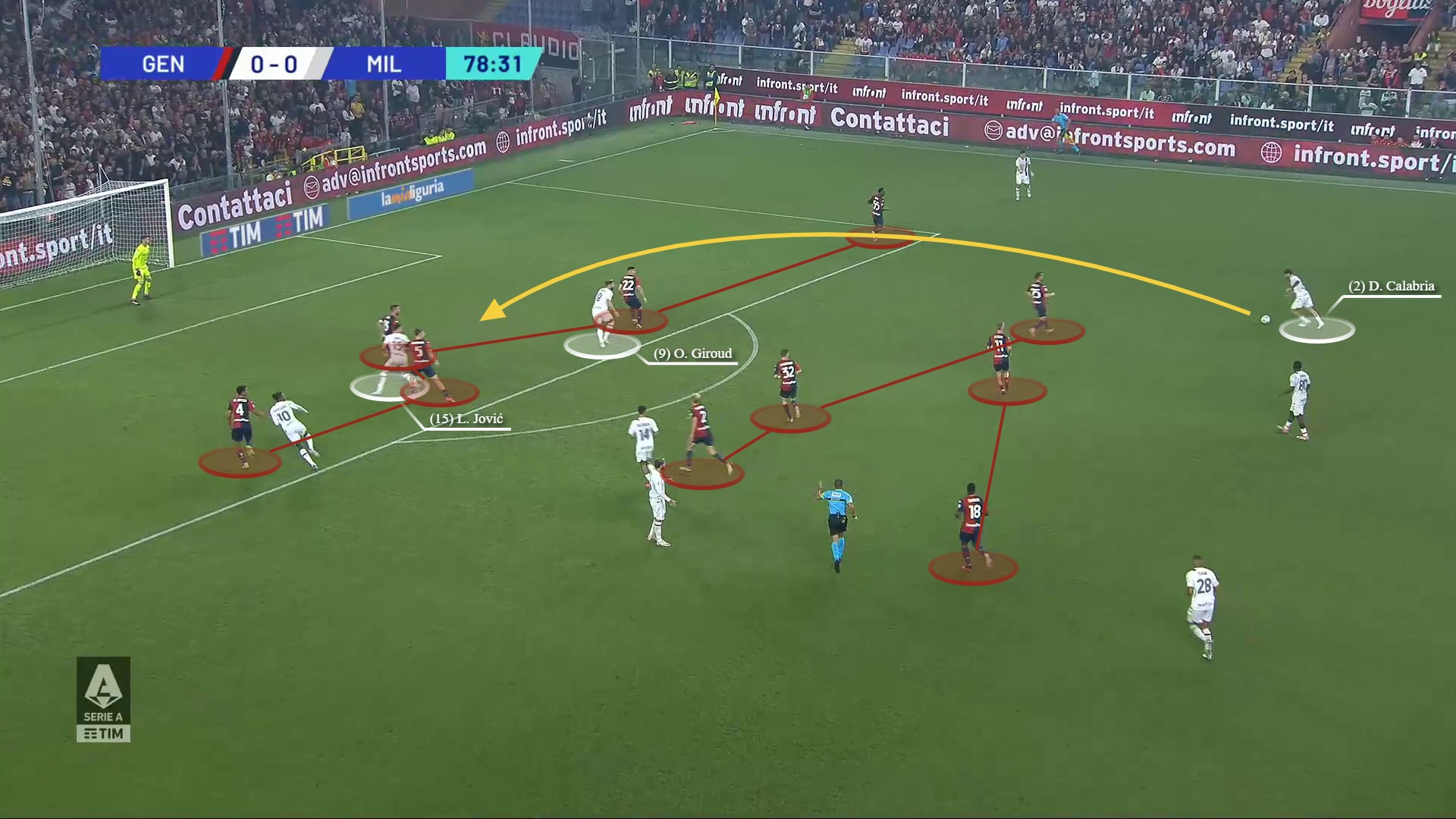
In the 83rd minute, Giroud and Jović were again occupying the three Genoa centre-backs and this enabled Milan to get Leão one-versus-one against Koni De Winter.

But despite Leão getting in behind the Genoa backline and having multiple targets inside the penalty box to aim for, his cross ended up with Calabria outside the area whose shot flew harmlessly high and wide.
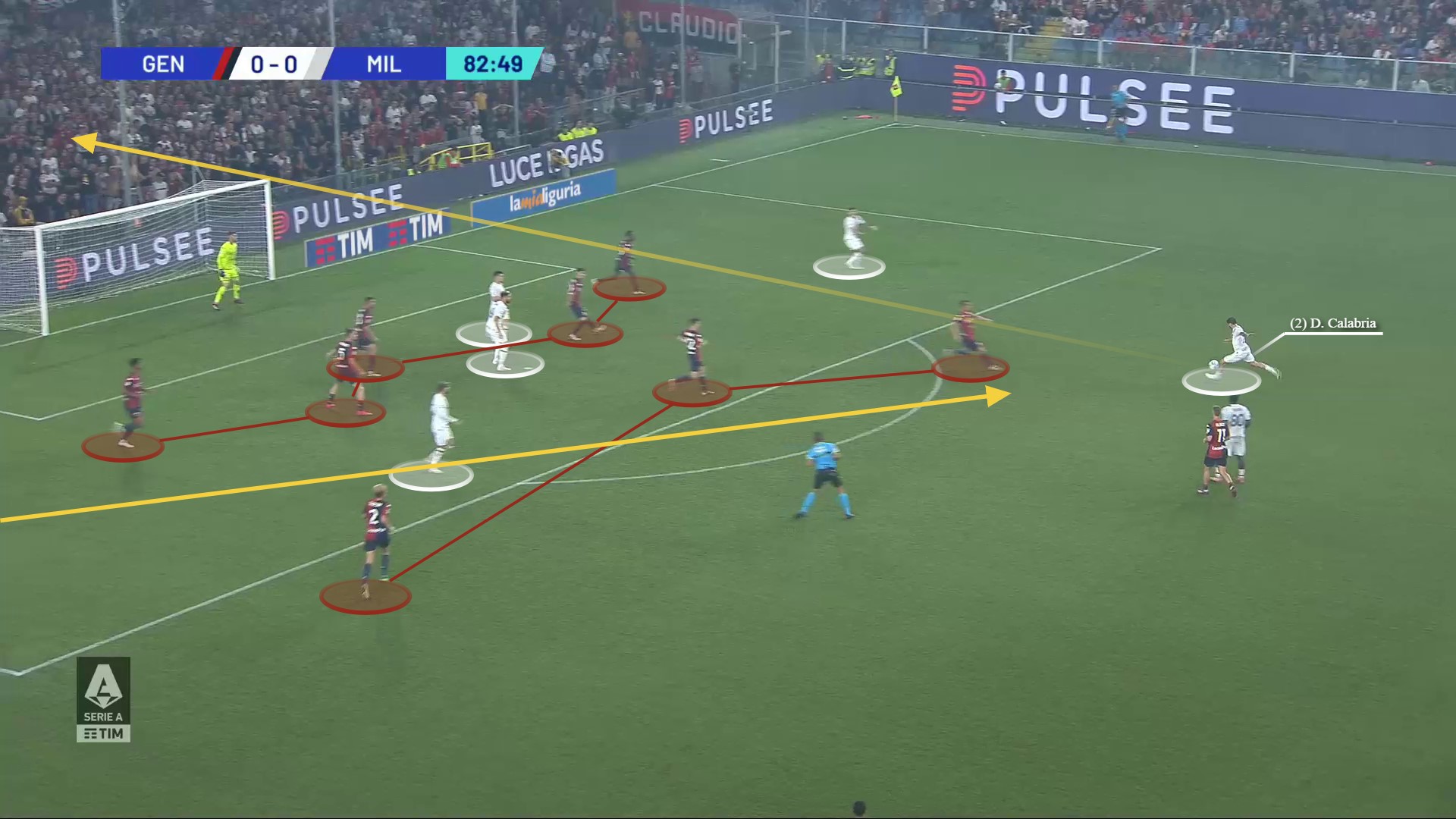
In the 85th minute, there was another example of how the presence of two Milan centre-forwards helped isolate the Genoa wingbacks. But on this occasion, Calabria overhit his pass in behind for Pulisic’s run and the ball ran out of play.

But in the 87th minute, Milan’s build up of continuous pressure eventually told. After taking a quick freekick, Hernández found Leão again isolated with the opposition wingback and played a pass in behind…
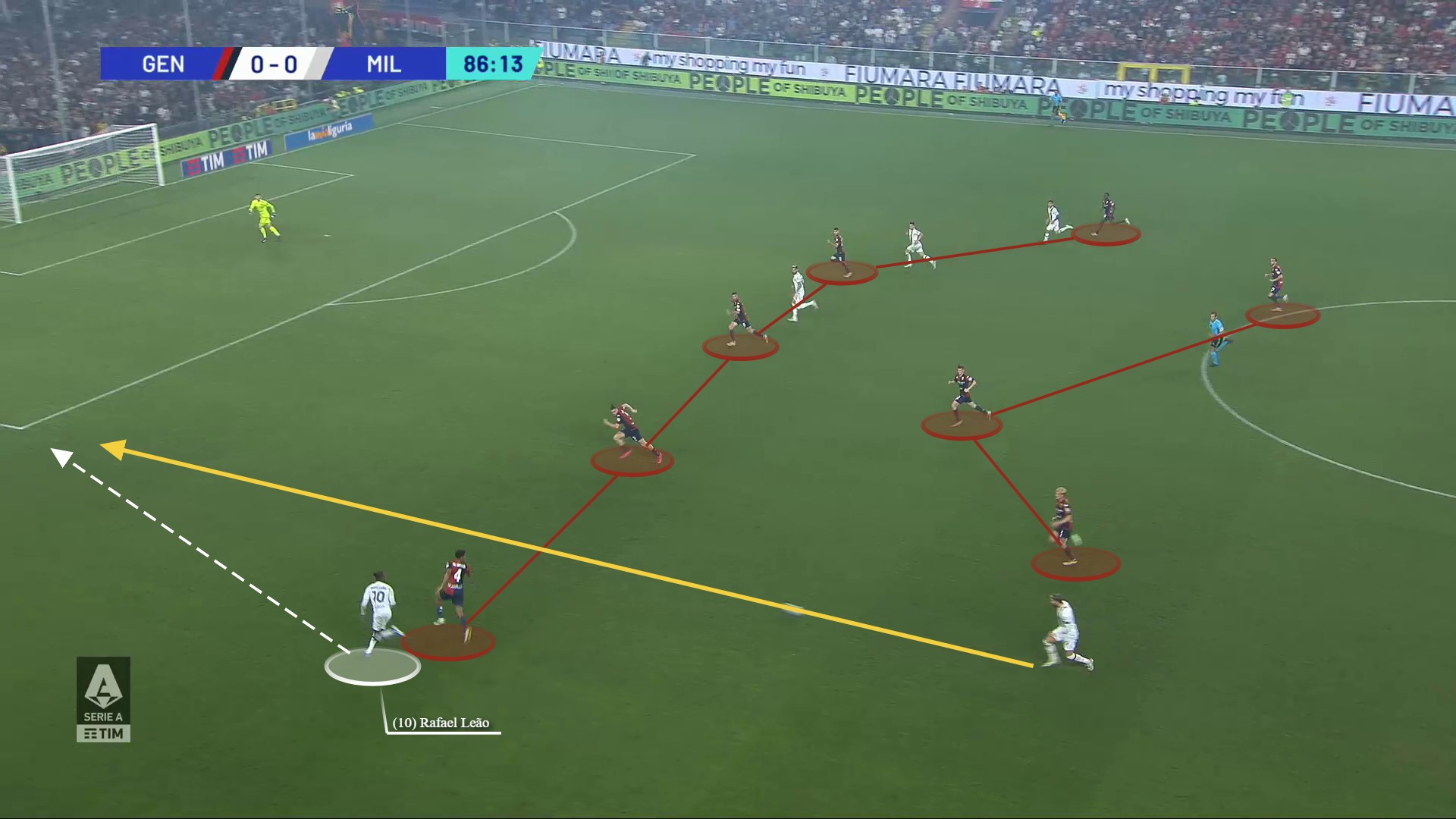
…which Leão crossed into the penalty box but Genoa were able to head away.
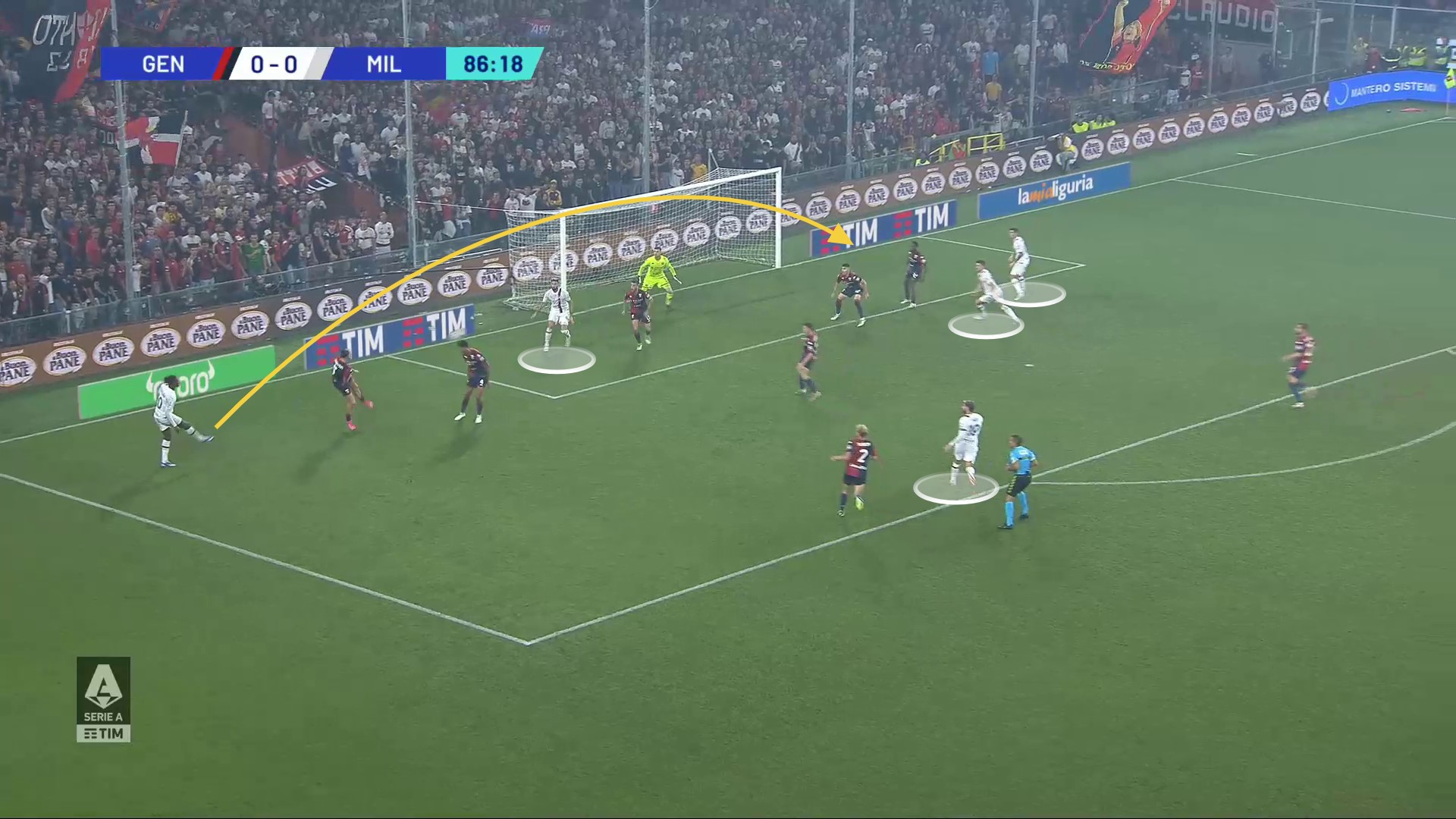
However, the attack did not end there. Milan regained possession and then found Musah in space out wide who put another cross into the penalty box.
Below you can see how the sheer presence of Giroud and Jović has taken all of the focus of the three Genoa centre-backs and as a result, Pulisic was able to…

…control Musah’s hopeful cross and then half-volley the ball into the back of the net to put his side into a late 1-0 lead.
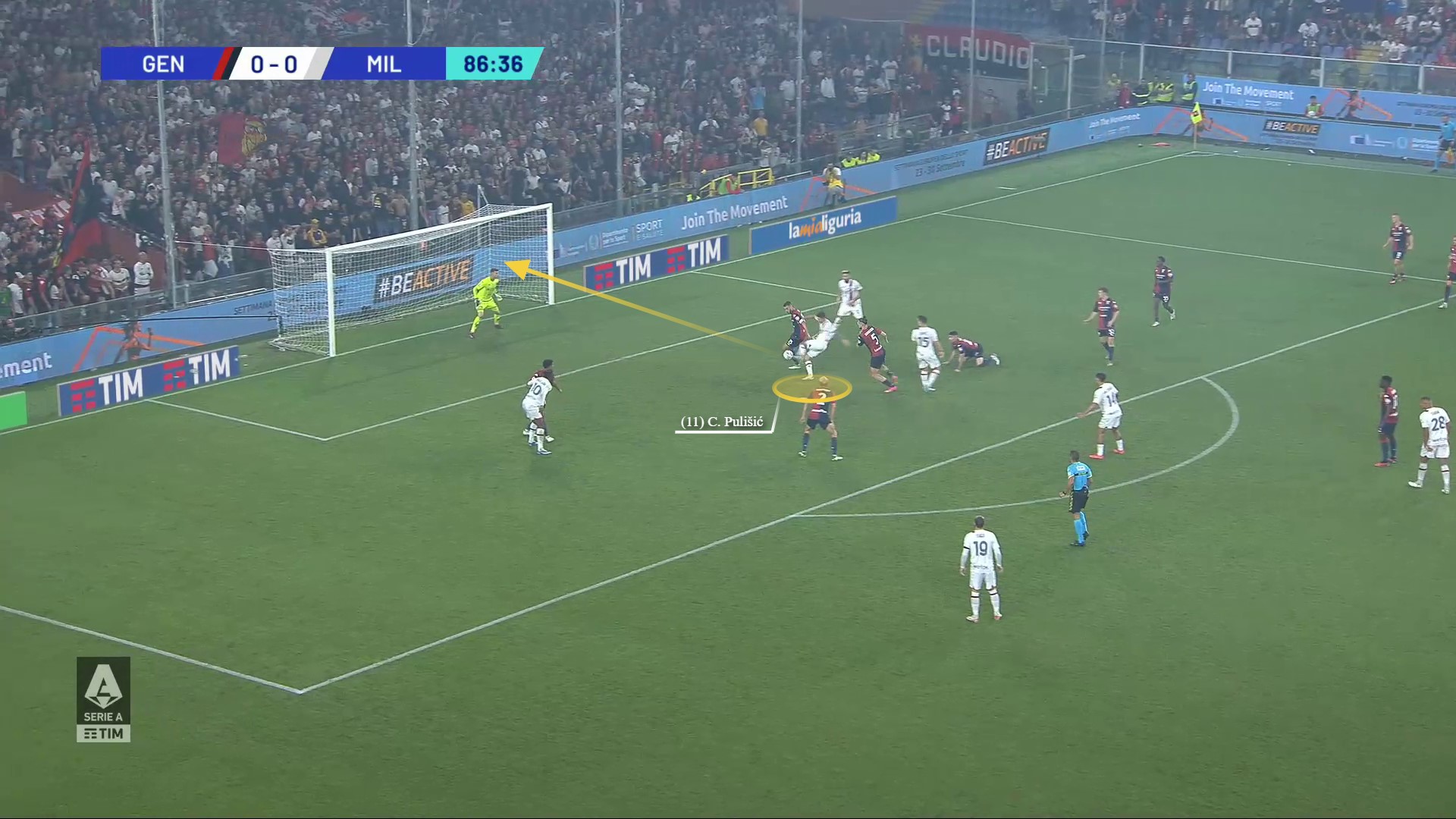
The drama did not end there, however, with red cards for either side’s goalkeepers and Giroud also making his presence felt as a makeshift Milan keeper.
Top of the league
Milan needed persistence to eventually beat the Genoa block. The home side will likely count themselves as unlucky that they did not come away from this game with at least a point following a spirited display.
But Milan found another way to win. It was not the most sophisticated but it was effective. And with Inter dropping two points at home to Bologna, the Rosseneri now head into the international break as outright leaders of Serie A.



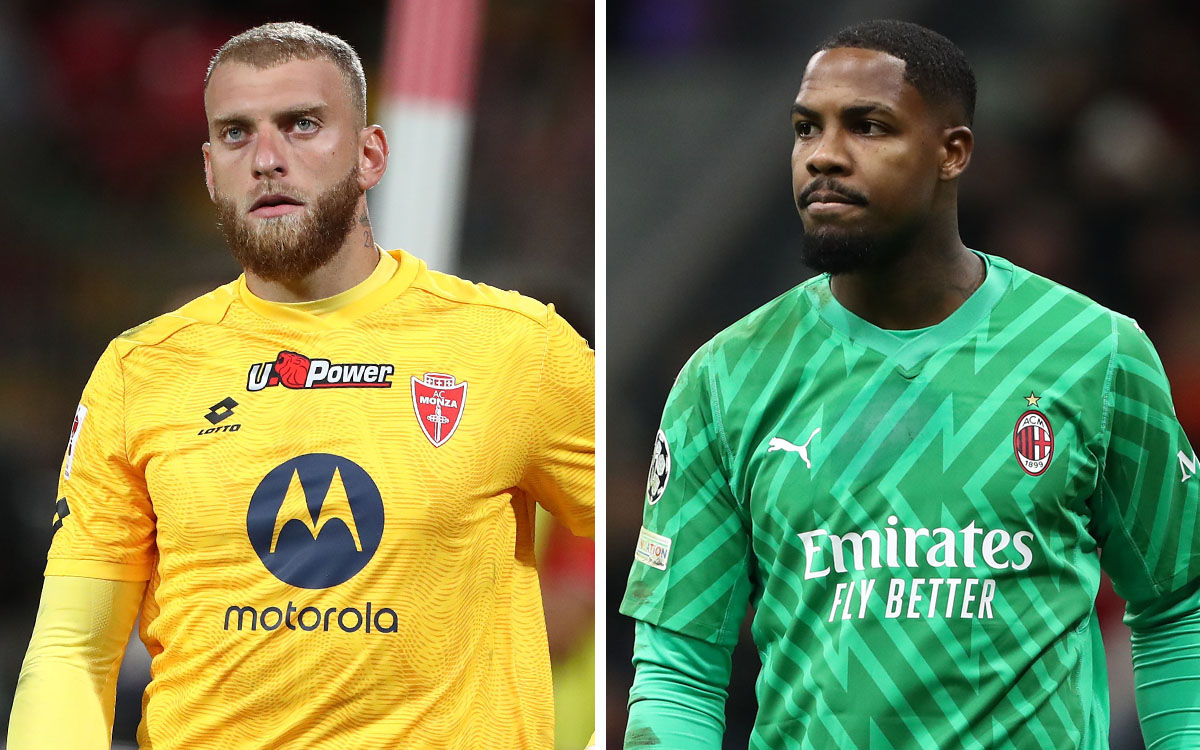
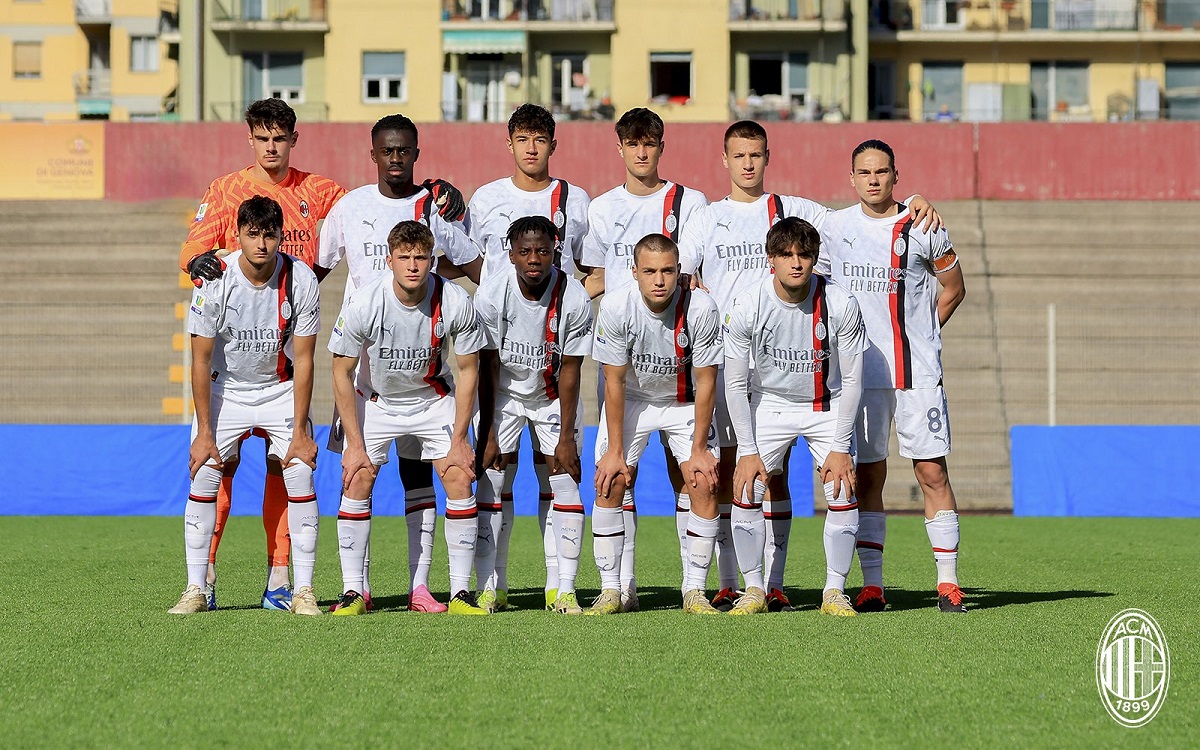
Absolutely 100 per cent …Girouds presence …
Yes it made a difference,,it enabled pulisic to create space …You need to watch this man’s position..
It’s hard to deal with his physical strength, and his ability to hold up the ball so well ..World class .
This man will definitely help us win the scuddeto this season …All our fans will be celebrating again
I found on the rewatch we had a lower low block than Genoa did lol 😂 so we really can’t complain when teams low block us in return
Musah’’s ‘hopeful’ crosses > Calabria crosses
solid but hopeful analysis Nick. Thanks